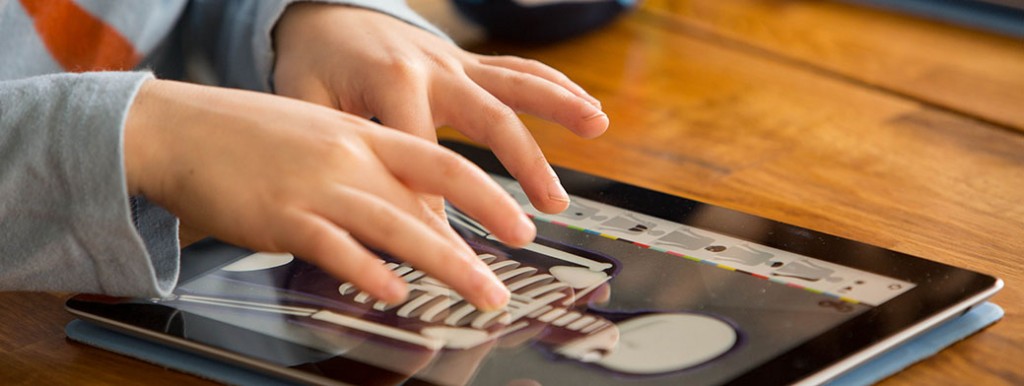
Apps For Impact started as a way to get Tinybop’s The Human Body in the hands of more kids.
The relationship between educational game developers and commercial giants like Apple is, at best, complicated. Student learning doesn’t always align with marketing goals, and even when it does digital inequity can get in the way of those games reaching the kids who need them most.
One project is trying to change that, one partnership at a time. Apps for Impact, helmed by Tinybop’s Kika Gilbert, is a program that seeks to shore up the rickety bridge across the digital divide by partnering kids’ app companies with nonprofit organizations to offer those apps to teachers free of charge.
“We don’t think that edtech or apps or something should exist in this silo, or bubble. We are currently building apps that help kids be inspired and find out more about the world around them,” Gilbert said. One such app is Tinybop’s popular The Human Body, which was developed during the earliest stages of the Apps For Impact initiative. Of that app, and others, Gilbert said: “We really wanted them to be accessible to all kids, not just the kids who could afford it. We really want to close the digital divide, and not have our apps just contribute to furthering that division.”
The road toward Apps For Impact started before the release of The Human Body in 2013, when Tinybop founder and CEO Raul Gutierrez was in conversation with investors Mitch Kapor and Freada Kapor Klein who wanted a look at the social impact of the app. Tinybop had already worked with Apple to provide promo codes to teachers to make the $4 app free. So Kapor and Klein asked them to “put it in writing and think big.”
When Tinybop returned to Apple for the additional codes, the tech giant encouraged them to “think even bigger,” Gilbert said. So Tinybop worked with Apple to become the App of the Week. Within that week, The Human Body was translated into 60 languages and downloaded 4.7 million times.
It was clear that a free app would reach more users. But it still wasn’t big enough for a company with its eye set on maximizing access to learning opportunities. To that end, the team decided to reach out to other app companies and nonprofits with a similar desire to reach underserved kids. Apps For Impact officially kicked off in September of 2015 with six companies – Tinybop, Hopscotch, Montessorium, Dragonbox, Motion Math and DIY – and the Brooklyn Public Library as the pilot nonprofit distributor.
In addition to the six apps currently provided, Apps For Impact also tries to offer teachers as much information surrounding each product available as possible: Participating teachers get access to resources and training to help implement each app in the classroom. Beyond school, Gilbert said another main goal of the initiative is to produce research that will help other developers better serve a diverse range of kids. “How do we take what we’re learning from those teachers and make sure that other app developers can benefit from it?” she said. “What does that mean for… other new developers who want to create apps for a particular demographic, but don’t really necessarily know the challenges that teachers and students have to go through every single day to even get the iPads integrated into a lesson?”
Gilbert continued to emphasize the important role that audience awareness plays both in developing and distributing educational apps.
“I think that for developers and for education technology to improve… they can’t just think that they know what the problems in the classroom are,” she said. “… For many schools where technology isn’t as available, isn’t as used the onboarding process is completely different.”
Apps For Impact is still new and, and there are still challenges ahead. Distribution is one key piece of the process Gilbert said is continually improving. The project is in talks for a potential partnership with nonprofit First Book, and is also exploring ways to “launch something with better approval from Apple,” Gilbert said.
She emphasized that one of Apple’s biggest questions for Apps For Impact has been that of distribution, and of getting the apps into the schools that need them. “Really, it’s a tech question as well as just getting the codes… [We need] the mechanisms to be able to distribute the codes, make [them] available for people on the web, for teachers to go to a website, click a button, be sent a code.”
The initiative hopes to expand nationwide, adding new tech companies and nonprofit partners to better reach underserved kids. In the meantime, Gilbert said, kids’ app developers can work to help reach more students by considering those affected by digital inequity.
“If developers are making educational apps they really need to understand the audience. And if edtech isn’t thinking about how to close the digital divide and serve all students, then I don’t think that it’s going to be that effective in the long run,” Gilbert said.
